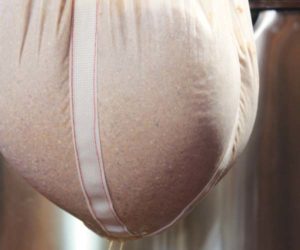Mastering the Step Mash: Tips from the Pros
Brewer: Daniel Rothman
Brewery: Cougan’s Brewery and Grill, Glendale, Ariz.
Years of experience: Eight
Education: Several short courses and on-the-job experience
House Beers: Responsible for maintaining a revolving program of eight to 10 beers on tap
Temperature program mashing, or step temperature mashing, is a process in which the mash temperature is increased in controlled steps. Most large breweries use temperature program mashing to maximize the extraction of sugars and to produce the most fermentable wort possible.
Greater efficiency and greater fermentability happen in this mash because the mash is brought through a range of temperatures at which both alpha- and beta-amylase, the two main enzymes responsible for saccharification (conversion to sugars) of the malt during the mash, are the most active.
Usually, homebrewers aren’t interested in eking out the last bit of efficiency from the grain. However, it can be fun experimenting with this type of mash for total fermentability. The key to temperature program mashing is to raise the temperature of the mash over time. Homebrewers can accomplish this in a few different ways. You can prepare a very thick mash at a rest temperature in the 120° to 130° F range, then slowly add boiling water to the tun while mixing the mash to gradually raise the temperature. But with this method, the mash thickness going from thick to thin can affect your efficiency and amylase activity, the very things you are trying to control with this type of mash.
The best method is to either heat your mash vessel or use a Recirculating Mash System (RMS). Recirculating systems do not heat the mash itself but heat the wort from the mash and recirculate it back into the mash to raise the mash temperature. One popular (and low-tech) method is to heat your mash tun on your burner. If you opt to do this, make sure you continuously stir your mash to prevent scorching.
There are two types of mashing programs, a modified program, usually known as the step mash, and the classic upward temperature profile.
The step mash begins with brewhouse calculations to determine what temperature the water needs to be to mash in the malt at about 135° F. A good liquid-to-grist ratio, is important so the mash won’t be prone to scorch when the vessel is heated. A ratio of 1.25 to 1.5 quarts per pound will be fine.
After the grain is all mixed in and settled at 135° F, let the mash sit a few minutes and begin ramping (raising the temperature) to the first step. The amount of time spent on the ramp here isn’t important as long as you don’t scorch the wort. (There may be some caramelization of sugars and darkening of the wort if the ramp is too quick.)
The key here is the step, say 140° F. Raise the heat to this temperature, then allow the mash to rest here for 30 to 45 minutes. This allows the beta-amylase to work. At the end of the rest, raise the temperature again, this time to 152° to 154° F, then rest for another 30 to 45 minutes. This will allow the alpha-amylase enzyme to work. At the end of the rest, ramp again to a final temperature of 160° F to help reduce viscosity. Then run off and sparge.
The classic linear temperature program mash is best done with the RMS system. Mash initially the same as for the step mash, only with this method there is no step or plateau. From the 135° F initial temperature, ramp up to 160° F over the course of an hour and a half. Since this is a 25-degree rise in temperature, you’ll need to spend about 3.5 minutes at every degree on the way to 160° F. This is the classic method and takes a bit more equipment and commitment than the standard single-temperature infusion.
Do you need to go to all this trouble? Well, it’s certainly possible to create a more fermentable wort. But what about the flavor? Is it better than infusion mash? There is much debate on this topic. By experimenting with one recipe and two brewing techniques, you can discover any flavor differences for yourself.


